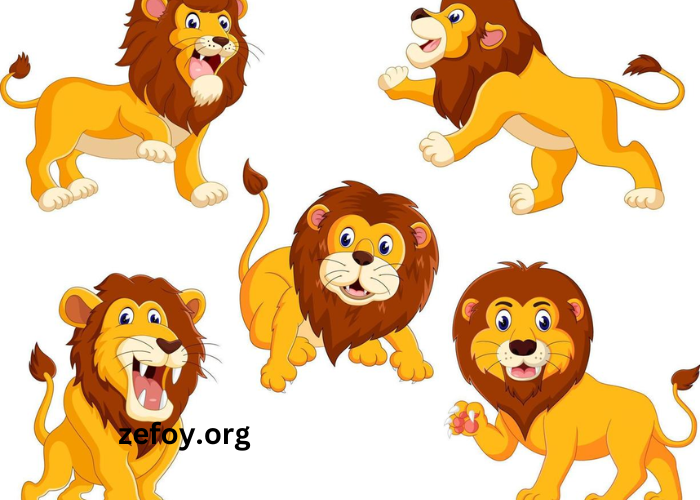Lions have long captivated the human imagination, symbolizing strength, courage, and nobility. The artwork labeled clipart:5xs5e-_R0we= Lion showcases these qualities, offering a vibrant representation of this magnificent animal. Whether in a playful cartoon style or a detailed realistic depiction, lion-themed clipart serves various purposes—from educational materials to branding. In this article, we will delve into the significance of lions in culture, explore different artistic representations, and discuss how clipart can be effectively used in various contexts.
What Makes Lions a Symbol of Strength?
Lions are often called the “King of the Jungle,” a title that reflects their position as apex predators. This powerful image has permeated cultures worldwide, where lions are associated with courage, bravery, and authority. The clipart labeled clipart:5xs5e-_R0we= Lion exemplifies these traits, often depicting lions in powerful stances or with royal features.
For instance, in heraldry, lions are frequently used as emblems of royalty and power. Their portrayal in this context elevates their status, making them symbols of valor and nobility. This cultural significance makes lion clipart not only visually appealing but also rich in meaning.
How Is Lion Clipart Used in Education?
Educational materials often utilize clipart:5xs5e-_R0we= Lion to engage students with fun and visually stimulating content. For instance, teachers can use lion illustrations in lessons about wildlife, ecosystems, or even the importance of conservation. By incorporating appealing visuals, educators can capture students’ attention and enhance their learning experience.
Moreover, clipart of lions can be useful in projects focused on animal behavior, biology, or geography. Students can create presentations that include the clipart to illustrate the lion’s habitat or social structures within prides. This use of art makes learning more interactive and enjoyable.
What Artistic Styles Are Commonly Found in Lion Clipart?
The versatility of clipart:5xs5e-_R0we= Lion allows for a wide range of artistic styles. From minimalist designs to elaborate illustrations, artists can convey different moods and messages through their work.
For example, a cartoonish lion might appeal to younger audiences, making it suitable for children’s books or educational resources. On the other hand, a realistic portrayal could be used in documentaries or wildlife conservation campaigns, emphasizing the lion’s natural beauty and the need for its protection.
Each style serves a unique purpose, and understanding the context in which the clipart will be used is crucial for artists and designers alike.
How Do Cultural Representations Influence Lion Imagery?
Cultural interpretations play a significant role in how lions are depicted in clipart. Different societies attribute various meanings to lions, affecting their artistic representation. For instance, in African cultures, lions are often celebrated in folklore and art, representing courage and strength in the face of adversity.
Similarly, in Western cultures, lions are frequently associated with royalty, as seen in British heraldry. This cultural context influences the aesthetic choices made in clipart:5xs5e-_R0we= Lion, whether that’s through color choices, posture, or accompanying elements like crowns or shields.
Understanding these cultural nuances can enhance the impact of the clipart, ensuring it resonates with the intended audience.
What Role Does Lion Clipart Play in Branding and Marketing?
In branding, the symbolism associated with lions can convey powerful messages about a company’s values and mission. Brands may choose to use clipart:5xs5e-_R0we= Lion to project strength, leadership, and reliability. For instance, companies in sectors like finance or security may utilize lion imagery in their logos to foster trust and confidence among consumers.
The visual impact of lion clipart can also create a memorable brand identity. The bold presence of a lion can make a logo stand out, helping businesses distinguish themselves in competitive markets.
How Can Creatives Use Lion Clipart Effectively?
To utilize clipart:5xs5e-_R0we= Lion effectively, creatives should consider the context and message they want to convey. For instance, a playful lion illustration may work well for children’s products, while a more serious depiction could be better suited for environmental campaigns.
Additionally, combining lion clipart with complementary graphics can enhance its effectiveness. For example, using lion imagery alongside natural elements like trees or grass can create a cohesive theme for a conservation project.
What Are the Benefits of Using Clipart in Design Projects?
Using clipart, such as clipart:5xs5e-_R0we= Lion, in design projects offers numerous benefits. Firstly, clipart provides quick and easy access to high-quality visuals, saving time during the design process. Designers can select appropriate images that align with their project goals without needing to create everything from scratch.
Secondly, incorporating clipart can add visual interest to a design. A well-placed lion illustration can capture attention and enhance the overall aesthetic of brochures, websites, or presentations.
Lastly, clipart can help convey complex ideas more clearly. Visual elements, like lion imagery, can complement written content, making it more engaging and easier for audiences to understand.
Conclusion
In summary, clipart:5xs5e-_R0we= Lion embodies the majestic qualities of lions while serving various practical applications in education, branding, and creative projects. The artistic representations of lions capture their strength and symbolism across cultures, making them versatile subjects for artists and designers alike.
As we continue to appreciate the beauty and significance of lions through clipart, we also recognize the important messages they convey about courage, leadership, and the natural world. Whether in an educational setting or a branding campaign, the impact of lion imagery remains profound and enduring.




